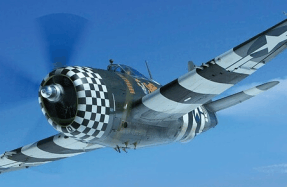
Mike Spalding, the chief pilot of the Military Aviation Museum (MAM), has more time flying DeHavilland’s Mosquito than any current warbird pilot. Just four of the twin, Merlin V-12-powered, wood airframe “Mossies” are airworthy today. The MAM’s DH-98, which first flew in 2012, has accumulated more flight time than any of the survivors, and 100 of those hours belong to Spalding.
Known as one of the fastest fighters/bombers of WW II, the “Wooden Wonder” as it was nicknamed is thought by many to be so speedy because its spruce, birch plywood, and balsa construction yielded what they assume is a lightweight airplane.
“No way,” says Spalding. “People think they’re much lighter but actually it’s the other way around. It takes a lot of wood to make a strong airframe. There are quite a few layers that are pretty thick, and the combat versions weighed over 20,000 pounds!” Contrast that with fast fighters like the P-51, F4U Corsair, and Fw-190, all of which have a takeoff weight roughly half that of the Mosquito’s.
RENOWNED EX-RCAF MOSQUITO PILOT GEORGE STEWART. STEWART HAD FLOWN THE MOSSIE DURING WW II. THE HIGHEST-TIME MOSQUITO DRIVER ALIVE GAVE SPALDING VERY VALUABLE TIPS.
Acquired by MAM founder and owner Jerry Yagen in 2004 from the Museum of Flight and Transportation in British Columbia, the museum’s DH-98 was built in Canada in 1945 as an FB26 fighter-bomber version and served briefly in the RCAF, never seeing combat. Sporting two Packard-Merlin 225s, as the Canadians designated them, operational examples could weigh as much as 21,473 pounds.
AvSpecs Ltd. near Auckland, New Zealand did a painstaking eight-year restoration/recreation of the Canadian relic made possible by the work of the late Kiwi restorer Glyn Powell, who built the molds needed for the fighter-version’s wooden fuselage, wings, and tail sections and used parts donated from as far away as Australia. Its first flight in New Zealand in 2012 was followed by a debut at its




